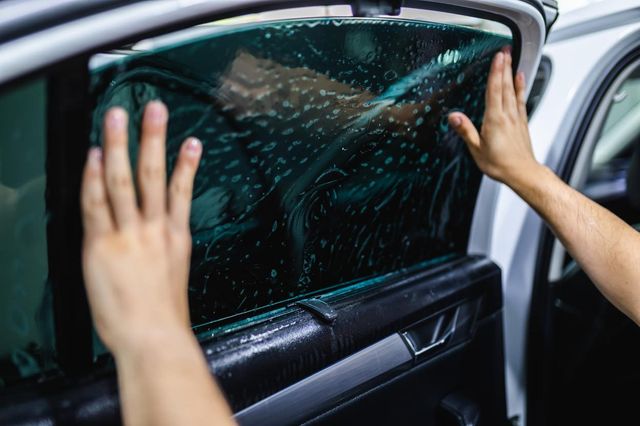A Comprehensive Guide to Recognizing Car Home Window Tint and Its Advantages
Automobile window tinting serves greater than just an aesthetic objective for cars. It offers numerous types, each with distinct features and advantages. Recognizing these choices, in addition to lawful guidelines and maintenance ideas, is necessary for any kind of lorry proprietor. The advantages might substantially improve driving comfort and lorry durability. As one explores the subtleties of window tinting, the inquiry develops: what type of color is best matched for private demands?
Understanding Vehicle Window Color: What It Is and Exactly how It Functions
Car window color functions as a safety barrier that improves automobile looks while offering useful benefits. This slim movie is related to the indoor surface of auto windows, lowering glare and obstructing dangerous ultraviolet (UV) rays from the sun. By filtering sunlight, automobile home window tint assists to manage the indoor temperature level of the vehicle, causing raised convenience for guests and decreased dependence on air conditioning.Additionally, it shields the vehicle's inside from fading, preserving both upholstery and dashboard materials. The tint can also boost privacy, making it extra tough for outsiders to see inside the automobile. Particular types of home window color can increase safety; in the event of a mishap, the movie helps hold shattered glass with each other, reducing the threat of injury from flying fragments. On the whole, vehicle home window color serves both practical and visual objectives, making it a preferred option amongst automobile proprietors.
Sorts Of Home Window Color: A Summary of Options
When considering window color choices, a number of types are readily available, each with unique attributes. Dyed, metalized, and ceramic home window tints offer varying degrees of warm being rejected, UV defense, and visual allure. Understanding these distinctions can assist car owners make educated options based on their preferences and demands.
Colored Home Window Tint
Dyed home window color stands for a preferred option among car proprietors seeking a cost effective and effective way to improve their automobile's aesthetics and privacy. This type of color is created by positioning a layer of dye in between a glue layer and a safety finish, causing a dark appearance that lowers glare and boosts visual comfort. While colored home window tint effectively blocks unsafe UV rays, it might not provide the very same level of warm rejection as other color types. Furthermore, its color can fade gradually, potentially lessening its efficiency. Despite these downsides, dyed home window tint stays popular for its cost-effectiveness and capacity to offer a streamlined, fashionable want to different lorry models.
Metalized Window Tint
Metalized home window color supplies an equilibrium of style and performance, making it a preferred selection amongst car owners. This type of tint incorporates metallic particles within the film, enhancing both aesthetic appeal and heat denial. The reflective quality of metalized color aids to lower glow and boost personal privacy, while also offering UV defense, which safeguards the car's interior. Furthermore, metalized home window color can enhance home window stamina, possibly protecting against ruining during accidents. However, it is very important to keep in mind that the metal parts can conflict with electronic signals, such as general practitioner and cellular phone function. Overall, metalized home window tint provides a reliable solution for those looking for a mix of durability, look, and sun protection for their vehicles.
Ceramic Window Color
Ceramic window tint stands for an innovative choice in the spectrum of auto home window films, using distinctive advantages over conventional colors. Unlike colored or metalized films, ceramic colors utilize innovative ceramic particles, which successfully deny warm and UV rays without jeopardizing presence. This technology ensures that vehicles remain cooler, minimizing reliance on air conditioning and enhancing gas efficiency. Furthermore, ceramic home window colors are less likely to disrupt electronic devices, such as general practitioner or mobile signals, making them a practical option for modern-day vehicles. Their longevity and scratch resistance contribute to a longer lifespan compared to other types of tints. In general, ceramic home window color provides superior performance, comfort, and security, making it a favored option for discerning vehicle proprietors.
Advantages of Automobile Home Window Color: Beyond Aesthetic Appeals
While lots of people associate automobile window tint with improved style, its advantages extend far beyond mere appearances. One substantial advantage is warmth decrease; home window tint can block as much as 99% of dangerous UV rays, safeguarding and keeping the interior cooler furniture from fading. This not only enhances convenience during warm climate however likewise reduces reliance on cooling, bring about enhanced fuel efficiency.In addition, auto home window color offers an added layer of personal privacy and security. Tinted home windows make it tough for outsiders to see inside the car, which can prevent theft and protect valuables. In addition, lots of tints reinforce the glass, minimizing the possibility of ruining in case of a crash, thereby improving safety.In addition to these functional benefits, auto window color can likewise add to glare reduction, boosting presence for motorists and guests alike. This multifaceted technique to convenience and safety and security makes window tint a useful investment for lorry proprietors.
Lawful Considerations: Tinting Regulations by State
Prior to dedicating to auto home window color, automobile proprietors should browse a complex landscape of tinting guidelines that differ by state. Each state has specific legislations regulating the permitted levels of color darkness and reflectivity for various windows, consisting of windscreens, front side windows, and back home windows. These guidelines usually consist of noticeable light transmission (VLT) portions, which determine just how much light can travel through the tinted glass.Some states permit darker colors on back home windows while limiting front side and windshield tints for security reasons. In addition, specific states may need a certification from the supplier to verify compliance with tinting legislations. Going against these policies can lead to fines, obligatory elimination of the color, or both. Consequently, it is important for automobile proprietors to investigate their state's legislations thoroughly to guarantee legal compliance before installing window color. This persistance can conserve money and time in the future.
Choosing the Right Color: Factors to Consider
When selecting the ideal home window color for a lorry, numerous important variables come right into play. Color darkness degrees, UV security ratings, and compliance with lawful laws are crucial considerations to assure both appearances and performance. Assessing these elements will assist individuals make an educated decision that fulfills their demands and adheres to local regulations.
Color Darkness Levels
Picking the proper color darkness degree is important for accomplishing the desired equilibrium between aesthetic appeals and functionality in auto home window tinting. Different states have differing legal regulations relating to tint darkness, which can influence the option. Generally, colors are measured in portions, with lower percents suggesting darker tones. Darker tints provide raised privacy and a streamlined appearance but can minimize visibility, especially in the evening. Alternatively, lighter tints keep a more open feel, ensuring appropriate visibility while still supplying some heat and glare reduction. People need to consider their driving behaviors, regional legislations, and personal preferences when deciding. Eventually, the best color darkness degree enhances the automobile's look while guaranteeing safety and security and compliance with lawful requirements.
UV Defense Score
Tint darkness degrees play a substantial duty in the overall effectiveness of vehicle home window tinting, yet one more essential variable to review is the UV protection score of the chosen tint. This rating suggests the portion of dangerous ultraviolet rays that the color can block. Premium tints often give 99% or even more UV protection, protecting guests and the vehicle's interior from sun damage. Davinci of Michigan. Long term direct exposure to UV rays can cause skin problems and fading of furniture, making a high UV protection ranking crucial for health and wellness and durability. When selecting window color, customers must prioritize this ranking along with darkness degrees to ensure optimum convenience and safety and security while driving. Recognizing these elements help in making a notified decision when spending in automobile home window tinting
Lawful Laws Conformity
Comprehending local legal laws is important for anyone considering auto window tinting. Each state or area has certain legislations governing the allowed degrees of tint darkness and reflectivity for various home windows. These policies often define the visible light transmission percentage, determining just how much light can travel through the tinted glass. Non-compliance can lead to penalties, compulsory elimination of the tint, or concerns during vehicle inspections. In addition, some areas may have constraints on the use of particular tinting products, calling for consumers to choose items that satisfy safety and security standards. It is vital for car proprietors to research their regional laws completely prior to selecting window tint to ensure conformity and prevent possible lawful problems.

Installation Process: DIY vs. Expert Providers
Exactly how does one make a decision between a do it yourself installation and hiring expert solutions for vehicle home window tinting? The choice commonly depends upon spending plan, experience, and preferred outcomes. A DIY method can be cost-efficient, allowing people to reduce labor costs. However, it needs a specific degree of ability and knowledge about the tinting procedure. Those who are thorough and person might locate success with do it yourself kits available in the market.Conversely, specialist solutions use experience and high-quality materials, ensuring a flawless coating. Specialists often assure their job, supplying satisfaction against possible problems such as gurgling or peeling. In addition, they are acquainted with regional laws pertaining to tinting, which can be complicated for the average car owner.Ultimately, the choice reflects an equilibrium between price, personal capacity, and the expected quality of the tinting task. Each option has its benefits, and the most effective option depends on specific scenarios and preferences.
Upkeep Tips: Keeping Your Color in Top Problem

Regularly Asked Concerns
How Much Time Does Window Tint Generally Last on a Vehicle?
Window color normally lasts in between 5 to 10 years, relying on variables such as quality, application, and ecological conditions. Routine upkeep and correct treatment can extend its lifespan, making sure perfect efficiency and look gradually.
Can Home Window Tinting Damage My Car's Original Glass?
Home window tinting, when used appropriately, does not damage a cars and truck's original glass. Improper installation or low-grade materials might lead to issues like gurgling or peeling off, potentially impacting the glass's honesty over time.
Is Home Window Tinting Safe for All Kinds Of Automobiles?
Home window tinting is usually secure for many automobiles, gave the movie abides by local policies and is effectively used. Some customized cars might need certain considerations, making it necessary to consult professionals before installation.
Will Window Tinting Void My Vehicle Warranty?
The question of whether window tinting spaces an automobile guarantee commonly depends upon the maker's policies. Typically, if the tint does not damage the car, guarantees normally continue to be undamaged. Getting in touch with the dealership is recommended.
Can I Remove Home Window Tint Myself if Needed?
Removing window color oneself is feasible, yet it requires cautious attention to prevent harming the glass. Individuals ought to utilize suitable tools and techniques to guarantee an effective elimination without leaving glue residue or scratches behind. While colored window tint efficiently blocks harmful UV rays, it may not supply the very same degree of warm read more rejection as various other color kinds. Ceramic home window color stands for an advanced option in the range of automotive home window films, offering unique advantages over standard tints. Before committing to auto home window tint, lorry owners have to browse a complex landscape of tinting policies that vary by state. These regulations often include visible light transmission (VLT) portions, which determine how much light can pass through the tinted glass.Some states allow darker colors on rear home windows while restricting front side and windshield tints for safety reasons. Tint darkness levels play a significant duty in the overall performance of vehicle window tinting, however one more vital variable to evaluate is the UV security ranking of the picked color.